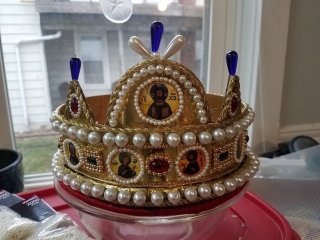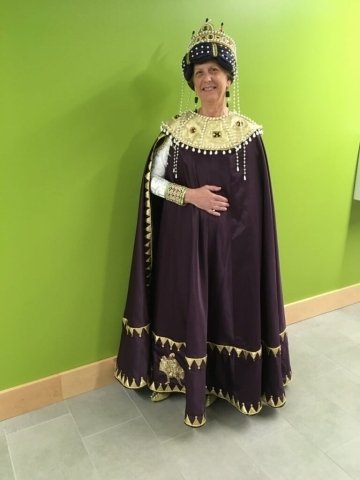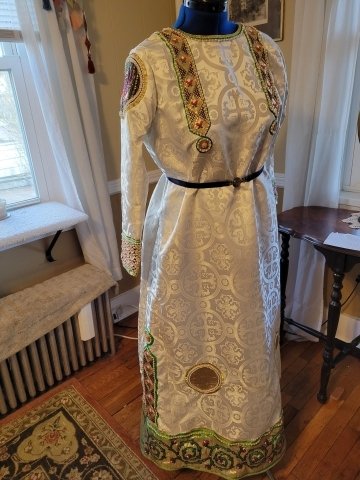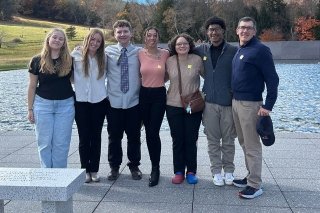Bringing history to life through clothes
University-wide
Posted


In 2019, history came alive at Bloomsburg University.
Deborah Walberg, an Art History professor, decided to recreate a costume from an Italian mosaic depicting the great empress Theodora to wear in her class. Since then, Walberg continues to recreate even more historical costumes for her classes including Isabella of Portugal, the wife of the Holy Roman Emperor Charles V; Abigail Adams, the wife of President John Adams; and Sappho of Lesbos, an ancient Greek lyric poet.
The success of Walberg’s initial Theodora costume inspired her to continue to create them for each of the courses she teaches. “I began to think about how I could better employ the costumes as part of my teaching, and decided they have to be as historically accurate as possible—no Halloween outfits!” says Walberg. “I now have a list of sixteen costumes from Ancient Egypt to the Roaring ’20s that will be constructed.”
Walberg has also begun to present her costumes for other classes. So far, she has presented an 1840’s costume and lecture on Victorian women’s wear for Nogin Chung’s “Women and Art” class and is preparing an Abigail Adams costume for Jennifer Oast’s “Women in Colonial America” class. “The whole project has more or less exploded. “I have created a new course from all of the research and work called ‘History of Fiber and Fashion.’” says Walberg.
Sewing has always been a large part of Walberg’s life. “I made my first dress when I was six years old while on

vacation at my grandmother’s house. My mother cut out the pieces and taught me how to put them together on her sewing machine,” says Walberg. “By the time I was twelve, I was making ‘Gone With the Wind’ costumes for my china doll, and because I was so tall, I had to make most of my own clothes in high school.”
“Sewing has always been more than a hobby,” explained Walberg. “I studied stage and costume design for the lyric theater in the Music School at Indiana University and was a professional tailor and costume designer before returning to school to study art history. One of my favorite jobs was renovating or redesigning old wedding dresses so a bride could wear her mother or grandmother’s dress.”
Each costume can vary greatly with how much time it takes to create. “The costumes for Sappho, the Ancient Greek poet, and Empress Livia, the wife of Roman Emperor Caesar Augustus, hardly took more than a weekend. The decoration, however, takes much longer,” says Walberg. “I use a variety of methods—hand painting, embroidery, applique, to name a few. It all takes a great deal of time. The applique border for the cloak of my Empress Theodora costume will not be complete for at least another three years.”
Walberg says that the most challenging aspect of the

project is finding the right fabrics and other materials. “Two of my wigs, the ones for Louis XIV of France’s mistress and Abigail Adams, came from France. The Byzantine belt buckle for Empress Theodora came from a historical reenactor online bazaar in Moscow. I order silk fabric and embroidery thread from India and the necessary high-quality linen from Germany.”
“The university gave me a $3,500 grant to help with the cost of materials,” says Walberg. “The cost per costume varies just as much as the time it takes to make one. Sappho’s costume was less than $100, but by the time I have finished the ensemble for Louise de la Vallière, the first official mistress of Louis XIV, I will have spent well over $1,200. The shoes and wig alone were over $700!”
Walberg’s favorite costume is a work in progress. “It’s not finished yet, but I can already tell it will be one of my favorites,” says Walberg.
“It is the 16th century Italian Renaissance costume for Veronica Franco, a Venetian courtesan, excellent poet, and early feminist.”
Each costume requires a considerable amount of research and creative work. “I am constantly working out motifs, creating free inventions on pre-existing designs, and adapting patterns within the realm of a period style. In the end, each costume is both a historical reenactment and an artistic creation,” says Walberg. “This is what makes it so fascinating and gratifying for me, and I love the opportunity to share this work with my students. BU has granted me this opportunity to develop this endeavor in a way that I doubt few other universities could have allowed.”



